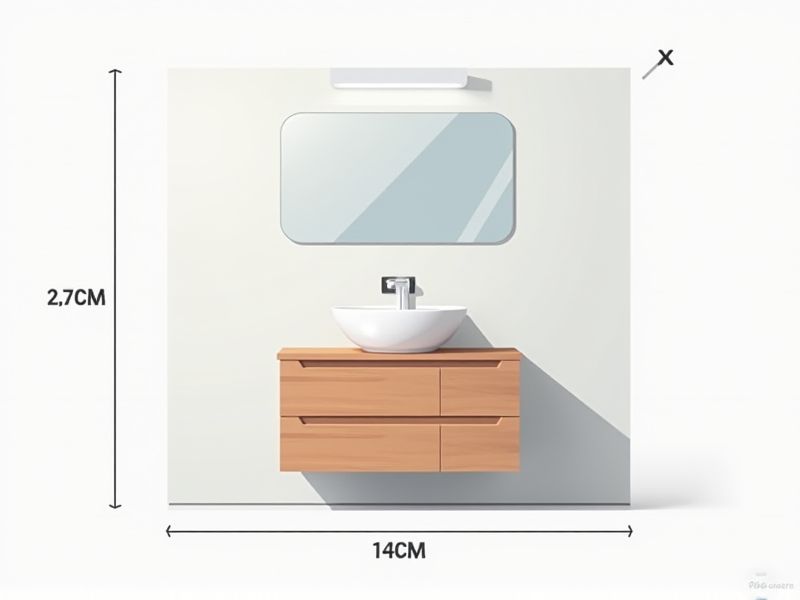
When selecting a bathroom vanity, understanding standard dimensions will help you make the best choice for your space and functionality needs. Most single-sink bathroom vanities typically range from 24 to 48 inches in width, while double-sink vanities are commonly between 60 and 72 inches wide. Standard vanity depths are usually around 20 to 21 inches, providing enough counter space without taking up too much room. Standard heights generally fall between 32 and 36 inches, ensuring comfort for a wide range of users.
Width
The standard width of a bathroom vanity typically ranges from 24 inches to 72 inches, catering to various bathroom sizes and storage needs. A vanity that is 30 to 36 inches wide is common for smaller bathrooms, providing ample surface area without overwhelming the space. For shared or larger bathrooms, a width of 48 inches to 72 inches allows for dual sinks and increased storage capacity, accommodating your family's needs. Selecting the right width not only enhances functionality but also contributes to the overall aesthetic of your bathroom.
Depth
The standard depth for a bathroom vanity typically ranges from 18 to 24 inches, catering to various space requirements and personal preferences. A deeper vanity, around 24 inches, offers increased storage capacity and countertop space, making it ideal for larger bathrooms. Conversely, a depth of 18 inches can fit snugly in smaller bathrooms while still providing essential functionality. When selecting your vanity, consider how the depth impacts the overall ergonomics and usability of your bathroom layout.
Height
The standard height for a bathroom vanity typically ranges from 30 to 36 inches. A height of 32 inches is commonly favored for comfort and accessibility, particularly for adults. In recent years, many homeowners are opting for taller vanities of 34 to 36 inches, catering to increased average height preferences. When choosing your vanity, consider the overall design and the needs of all users to optimize functionality and comfort.
Sink Type
When selecting a bathroom vanity, the sink type significantly influences both functionality and aesthetics. Common sink types include undermount, vessel, and drop-in, with undermount sinks often providing a seamless look that's easier to clean. For dual-sink vanities, opting for two separate sinks can enhance convenience, especially for families, as it allows simultaneous use, promoting efficient morning routines. Consider materials such as porcelain, stainless steel, or glass for your sink, as these choices can impact durability, maintenance, and overall visual appeal.
Countertop Size
The standard bathroom vanity countertop size is typically between 24 to 72 inches, accommodating various needs and spaces. A common choice for smaller bathrooms is a 30-inch wide countertop, while master bathrooms often feature larger options, such as 60 inches or more. For optimal function, ensure a depth of at least 20 inches, providing ample space for sinks and accessories. When selecting your bathroom vanity countertop, consider materials like granite or quartz, which not only enhance aesthetics but also offer durability and resistance to moisture.
Cabinet Space
When selecting a bathroom vanity, prioritize **cabinet space** to maximize storage efficiency. Average dimensions for a standard vanity range from **24 to 72 inches** in width, accommodating various bathroom sizes. A well-designed vanity typically includes a combination of **drawers and shelves**; aim for at least **30% more storage** than your current setup for improved organization. Choose materials like plywood or solid wood for durability, ensuring your investment stands the test of time while providing ample space for toiletries and linens.
Legroom
A bathroom vanity should ideally provide at least 30 inches of overall height to ensure comfortable use for most individuals, with a knee clearance of around 24 inches for legroom. The recommended depth of a vanity ranges from 18 to 21 inches, allowing for adequate space to kneel or sit while utilizing the sink. Choosing a vanity that is wall-mounted can further enhance legroom, as it offers floor space for mobility and easier cleaning. For optimal usability, consider the width of the vanity, which should generally be between 24 and 72 inches, accommodating your storage needs without compromising comfort.
Mirror Size
When selecting a bathroom vanity, the mirror size plays a critical role in enhancing both functionality and aesthetics. Standard mirror dimensions typically range from 24 to 60 inches wide, depending on the vanity size and the overall bathroom layout. A mirror that is approximately 5 to 10 inches narrower than the vanity width creates a balanced look, providing ample reflection without overpowering the space. Ensure your mirror is mounted at eye level, typically around 54 to 64 inches from the floor, for optimal usability and a flattering view.
Faucet Clearance
Faucet clearance for bathroom vanities typically ranges from 1 to 2 inches above the sink rim to ensure comfortable use without splashing water. For a standard height of 32 to 36 inches for vanities, this clearance helps accommodate a variety of faucet styles, including single-handle and widespread designs. Proper faucet clearance not only enhances functionality but also prevents any interference with the mirror or backsplash, ensuring a seamless aesthetic. When selecting your vanity faucet, consider a spout height of at least 6 to 8 inches for optimal water flow and ease of use.
Storage Options
A bathroom vanity typically includes various storage options to enhance functionality and organization. Many vanities feature drawers and cabinets that utilize space efficiently, with sizes ranging from 24 to 72 inches to fit diverse bathroom layouts. Look for models with adjustable shelving, allowing you to customize spaces for items like toiletries and towels. Consider options with soft-close mechanisms, which not only provide a quieter experience but also increase the durability of your storage solutions.
